Struggle with climbing stairs? Here are some tips to make it easier
Picture this: You’re up and walking about, doing some shopping – you’re got some large bags, heavy with food for the week. You are done for the day, so you approach the elevators to get back to your car, parked on the upper level, but what's this? An ‘Out of Order’ sign stares back at you from the metallic doors. As you step away, feet pounding and legs aching from the hours of walking, a fearful thought dawns on you - you have to take the STAIRS!
.png?width=600&name=BJC%20Facebook%20Post%20(35).png)
You approach the first step, unsure of your strength. ‘Will my knees hurt?’ you ask yourself, ‘What if I fall?’. You grip onto the railing unsteadily and begin the ascent. The first few steps are uneventful, but after a few moments your knees begin to shake with fatigue. Your breath becomes heavy, sweat glistens on your forehead. You reach the first level, and take a moment to recover. You still have 4 more flights of stairs to go!
You finally reach your car, load your bags, and begin your drive home. Your legs are throbbing from the stair climb, but your day is done. As you make your approach back home, up a steep and winding hill, your car starts making weird noises – the sputtering and clunking sounds of a dying engine. This can’t be happening! The ice cream won’t last if you wait for the tow truck! Now, you’re tasked with walking UP THE HILL back home with a heavy load. The fear and thoughts from the stairwell re-emerge.
I've taken the liberty of embellishing this particular scenario. But daily tasks, such as climbing stairs and walking uphill, don’t have to become dreaded or worrying experiences.
You might be thinking “Climbing stairs and uphill walks ARE so hard now, it must be a normal part of ageing” which is true, however, there are a number of things you can do to help prepare yourself for the day I described above, and tackle any difficult tasks with more confidence.
Gradual Progression is Key
If stairs and hills are the ‘lock’, then gradual progression is the ‘key’ that will help you open up to more challenging tasks.
Gradual progression is a simple concept: introduce smaller, more manageable activities with the goal of completing a bigger, more strenuous task.
When it comes to stair climbing or uphill walking, it can be as easy as changing your daily walking route to include a small hill or a set of stairs in the area – challenge yourself with 1 or 2 attempts of each when walking. As your confidence improves, you can start doing a bit more every other day. Eventually, your daily walk will become its own adventure, traversing up and down hills, involving varied difficulties of stairs.
But what if you don’t live in a hilly area, or near any stairs? The next tip can be a ‘strong’ complement or alternative…
Strength for Stairs
Improving the strength in your legs is paramount to building your confidence when it comes to stairs and hills. Strength isn’t just about building big muscles – strength can also be your ability to repeat a task without experiencing fatigue. If your leg muscles are stronger, then you’ll be able to climb any staircase without tiring too quickly, and likely experience a reduction of pain in the knees, and a feeling of stability and balance as you take each step.
So how do we create such strength you ask? By using the first tip of ‘gradual progression’. I’ve provided a couple of example exercises you can start with from the safety of your own home, and ways you can progress them:
1. Sit-to-Stand
- As the name suggests, start on a comfortable chair with your feet hip width apart and your arms across your chest
- Leaning forward over your feet, push through your heels and stand up by straightening your knees, keeping your chest high.
- Reverse the movement by pushing your hips back towards the chair, keeping the weight in your heels and ensuring your knees stay in line with your toes.
- Repeat this movement for 10 repetitions, repeating 3 times with a rest between each set.
- To progress, you can increase the repetitions to 15, or hold a light weight, such as a dumbbell or a bag.
- Try 3 sets of 10 repetitions to start with
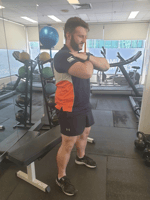
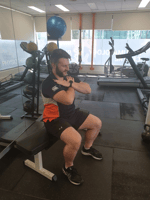
2. Wall Sits
- Start with your hips and back against a solid wall.
- Walk your feet forward away from the wall, keeping the pressure of your back and hips against the wall
- Slowly slide your back down the wall by bending your knees, until your knees are bent just above 90 degrees.
- Hold this position for as long as possible, building up to 30-seconds
- Rest and repeat 3 times
- To progress, increase the hold by 10-seconds, up to a maximum of 60-seconds
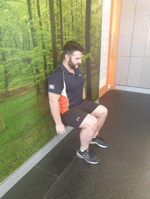
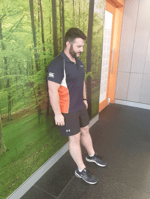
3. Single-Leg Balance
- Standing with feet hip width apart, ensure you stand proud and with proper posture.
- Transfer your weight onto one leg by lifting the other leg off the ground slightly
- Feel free to hold onto a chair to stabilise; as you feel confident, begin to let go of the support for longer periods
- Hold this position for 30 seconds, ensuring your hips stay level throughout. Try to repeat 3 x on each side.
- To progress, hold for longer periods, or as you are holding, toss a ball from one hand to the other to challenge your balance.
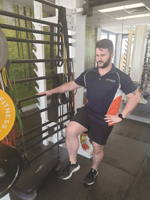
4. Assisted Step Ups
- Choose a step that you feel comfortable starting with.
- Set up, holding onto either a TRX or a railing/bar beside you.
- Start with placing one foot firmly on the step.
- Using your strength, push down through your heel as you step up onto the step.
- Gently control they way down, keeping your chest and head proud.
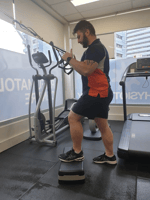
Strength is a fantastic way to help develop your confidence and improve your ability to perform day-to-day tasks with ease, but another type of exercise can’t be neglected.
Aerobic Activity is Awesome
Aerobic or Cardiovascular exercise is also a vital part of building up our capacity to climb up hills and stairs; it enables our heart to pump blood more efficiently, feeding our muscles with oxygen, and ensures fatigue doesn’t set in too quickly. As mentioned before, a simple walk around the area can be sufficient, but using the first point of gradual progression, we need to always be doing a little bit more every time we venture out.
If you do enjoy a daily walk, you want to walk at a pace that will elevate your heart rate; you don’t want to dilly-dally about – make it worthwhile and challenge yourself by doing your usual walking circuit a bit faster each time you attempt it.
Using hills and stairs within your walk will also add a natural progression – if you have a set of stairs in your own home, use them to finish your walk!
One key factor when enjoying any aerobic exercise, whether its walking, swimming or cycling, is ensuring you are challenging yourself. If you’re unsure if you are working hard enough, then use a simple number scale, where 1 is easy, not challenging at all and breathing normally, and 10 is impossible to maintain and you’re breathing very heavily. We call this scale ‘Rating of Perceived Exertion’ or RPE, and it will be different for everybody, so it’s a great way to challenge yourself as an individual - try to aim between 6-7 out of 10 to help improve your fitness.
Using the tips above, I hope your next experience with any stairs or uphill climb is done with more confidence. If you’re still unsure or confused about anything I’ve discussed here, please feel free to reach out and contact one of our Exercise Physiologists at BJC Health.

